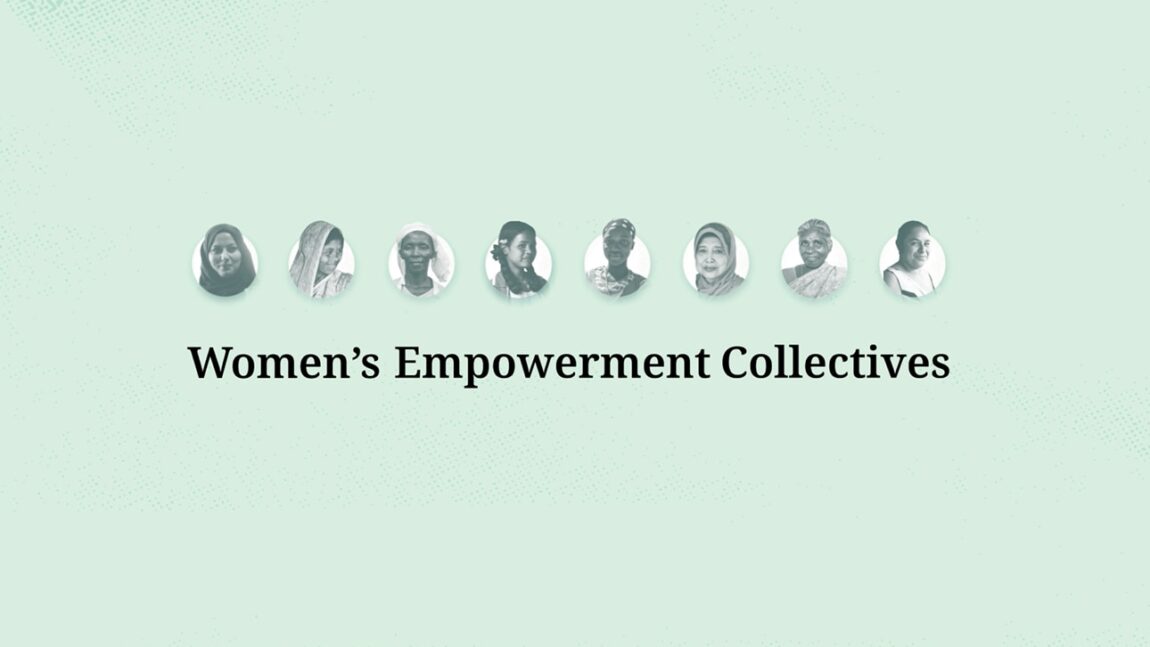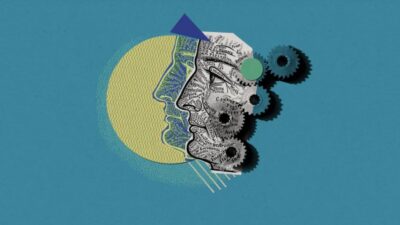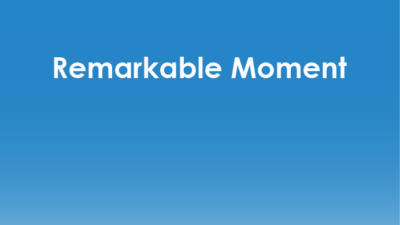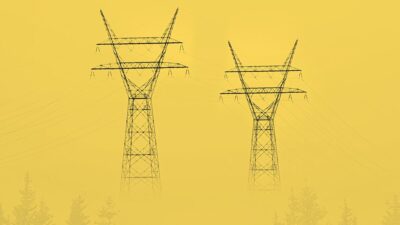Around the world and throughout history, women have come together in different types of groups to offer each other support and address barriers together.
By Katherine Hay
These groups have created resilience, often in the absence of other safety nets, and fostered opportunities for women and their families. The power of these groups has been rooted in the solidarity that comes from face-to-face connection and joint problem solving.
But what happens when coming together is made impossible by a pandemic? Do these groups help women withstand the crisis? Do the groups themselves survive?
It was clear early in the COVID-19 pandemic that women would be uniquely impacted – as they had been in previous shocks like the 2008 financial crisis and 2014 Ebola epidemic. The question was not whether – but how deeply women would be impacted, how inequities would manifest, and what platforms or policies might offer some support to them.
We quickly brought together our grantees and partners to collect data on impacts, to hear from women directly, and to review evidence on policies that were taking shape (or had worked in the past) to mitigate impacts. With our partners, we tried to understand the gendered economic impacts of the pandemic and to identify gender responsive programs and policies that would put women at the heart of what we knew needed to be an unprecedented recovery effort.
One of the platforms we thought would help women and families weather this storm was women’s groups, or women’s empowerment collectives.
Please read on for more information on why the Gates Foundation supports women’s savings groups, self-help groups, and empowerment collectives in South Asia and Africa, and we believe they can help advance gender equality and be an important part of the economic recovery efforts as countries work to rebuild more inclusive economies. We are so pleased to see women’s empowerment collectives featured as one of the calls to action of this year’s global Generation Equality Forum.
Together with our partners, we are supporting countries in building out national programs that form and link women’s empowerment collectives to economic and social supports and markets. We are also working with innovators to test new digital tools, contextualize and roll out gender and norm-change curricula, test new enterprise development models, and create stronger links to health care and other services—all the while trying to lower the cost of running and scaling up women’s groups.
We’ve seen that when women come together, they can collectively overcome some of the barriers and biases that hold them back, even as we work to rebuild the systems and institutions that created the barriers in the first place.
Together with a consortium of researchers and practitioners, we reviewed how COVID-19 has affected these groups and how women’s groups helped mitigate the pandemic’s negative consequences. I’m really pleased to share some of this evidence below. I hope you will find the review helpful.
Special thanks to the members of our team who were co-authors on this report, and to our collaborators: Africa Centre for Systematic Reviews and Knowledge Translation, the School of Women and Gender Studies at Makerere University, BRAC, CARE, the Evans School Policy Analysis and Research Group at the University of Washington, the Global Center for Gender Equality at Stanford University, the Population Council, MarketShare Associates, the SEEP Network, and American Institutes for Research.
Evidence Review of Women’s Groups and COVID-19
Impacts, Challenges, and Policy Implications for Savings Groups in Africa
Introduction: Overcoming barriers to equality
Women do not get an equal start in life.
Across the world, they are surrounded by barriers from the moment they’re born. Gender inequality—women and girls being treated differently and being disadvantaged in comparison to men—means being on an unequal footing in life.
The barriers that women face are often ingrained socially. These can be constructed by their immediate family or cultural customs in the places they live. These broad social barriers are often reinforced by structural barriers, such as lack of services and gender inequality in the laws and policies that shape their lives.
Too often, girls and women are taught to assume roles and behaviors that further entrench the barriers they face. We can see this in their lack of economic mobility, educational access, agency over their body (early marriage, family planning) and life choices (livelihood or entrepreneurial opportunities). These barriers dictate the spaces women are allowed to occupy, by denying them escape or access.
For example, 40% of countries have laws constraining women’s ability to join and remain in the labor force. Yet globally, women do three times more unpaid care work than men. In India, they do 10 times more. These women work, but without the same rights and rewards that men have.
These barriers create a world that belongs to men. Quite literally, in fact. Women farmers perform up to 75% of farm labor in Ethiopia but own barely 19% of the country’s agricultural land. Empowering women and overcoming inequality is a global challenge that is longstanding and complex.

It is impossible to approach this challenge without a clear understanding of what is really meant by empowerment. Unlike power, empowerment is not something that can simply be given. If power means control—over resources, over ideology—then empowerment is the activity of gaining this control.
Women’s empowerment is about changing existing power relations. It is about expanding women’s power over their own lives. It is both a process and an outcome.
In communities around the world, women are participating in this process by organizing and supporting one another through groups. Examples include savings groups, self-help groups (SHGs), mothers’ groups, community mobilization groups, and groups for adolescent girls.
Typically, members volunteer their time, labor, money, or other assets and have regular face-to-face meetings. These groups serve as spaces where women can socialize, build connections, and work toward their economic or political goals.
Whatever form these groups take, their greatest benefit is in offering a platform for reaching many women at once with resources, information, and training. By harnessing the collective power of their members, the groups can achieve positive impacts that would be harder or impossible to achieve through interventions that focus on individuals.
Over the years, these groups have gradually taken on more and more of the issues that women face. They provide a way to break through barriers at home, in the community, and beyond.
These groups, broadly known as women’s empowerment collectives, are based on a fundamental truth: When women come together, they all become stronger. This is especially true for women in low-income households. These women find power in pooling resources, sharing risks, and using their collective strength to negotiate the deep-rooted social and cultural barriers within families and communities.
But the benefits of women’s collectives magnify far beyond the women themselves, dramatically affecting their communities and the broader economy at every level, from local to national. We are all better off when women are empowered.

Women’s collective power
By the simplest definition, a women’s empowerment collective is a group of women who meet regularly to achieve a shared purpose. But these groups take many forms across the world, with women coming together for different economic, legal, health, and cultural reasons.
In Africa, the focus is often on group lending and credit by pooling small weekly savings into a common fund. In Asia, many collectives have had a strong emphasis on gaining access to formal financial services. And this is just the start. There are mother’s groups, livelihood groups, governance groups, support groups for HIV and AIDS, and more.
Within all of these groups, women understand that they are not alone. They gain a voice for demanding and effecting change. Together, they are empowered to take action and hold people accountable for the changes they need.

The combined effect of all these elements leads to remarkable impact in women’s empowerment. From learning about new income-generating opportunities to acquiring basic literacy, women have been empowered in every area where they face social, economic, and political barriers.
Socially, women’s collectives can give women greater influence on issues like reproductive health and female autonomy. Economically, a poor woman gains strength as part of a group. Evidence shows that groups provide an effective platform for helping women access financial services. Women can gain more power to generate income and make decisions within the home. Women also benefit from the social networks, moral support, and mutual accountability offered by these groups.
Collectives can leverage these strategies—from social involvement to savings—to empower women on an even broader level: Allowing them to participate politically, hold their governments accountable, and lead collective action.
Whatever their objectives, these collectives give women opportunities to be heard. And they can play a central role in promoting gender equality, reducing poverty, and sharing prosperity.
Success in South Asia and beyond
Countries in South Asia have the longest documented history of women’s collectives. Since the 1970s, women’s groups in various parts of India have been organized and mobilized by civil society organizations, including nongovernmental organizations and social movements. The national and state governments have increasingly provided structured support and services for these groups over the past three decades.
Most significant among the government efforts is the Deendayal Antyodaya Yojana National Rural Livelihoods Mission (DAY-NRLM). Launched in 2011, it was designed to empower rural poor people to increase their household income.
The unique strength of the program lies in its structure. It established women’s self-help groups (SHGs) in more than 100 high-poverty districts across 13 states in India. SHG members run the program with the help of government support structures and have scaled it up to reach the remaining districts and states.
The impact of this nationwide project has been huge. Over 70 million women have been mobilized into SHGs and their federations, which are owned, managed, and represented by women. Evidence has shown that households participating in the program reported a 19% increase in income over two and a half years. And among other impacts, fewer households reported going hungry or taking out high-cost informal loans.
This template for progress has been replicated in many other places. The Nigeria for Women project aims to expand over the next 10 years across 18 states and 36 local government areas in Nigeria’s six geopolitical zones. In Uganda, the sustainable livelihood subcomponent of the Third Northern Uganda Social Action Fund (NUSAF 3) has so far been implemented in nine districts and will reach 20 more districts and another national project, Development Response to Displacement Impacts Project (DRDIP), which covers an additional 15 districts.
Not only are these programs mobilizing women into groups—giving them identity, voice, and agency—but they are having a positive impact on their lives and livelihoods. In Uganda, for example, connecting youths to formal employment through savings groups resulted in a 39% decrease in members living below the $1.90-per-day poverty line.
Indeed, being a group member can provide a level of resilience that extends far beyond household finances. Evidence has shown that pregnant women who were exposed to collectives with participatory pregnancy planning experienced a 49% reduction in maternal mortality and 33% reduction in neonatal mortality.
Resilience in the face of COVID-19
Togetherness is the power source of women’s empowerment collectives. So what happens when coming together is made impossible by a global crisis?
The outbreak of COVID-19 brought into sharp focus the huge importance of digital technology to women. It has long been clear that digital apps make bookkeeping significantly easier than paper-based accounting, helping group members to collectively and confidently track their finances. This also helps in building the credit profile of SHGs women members, which helps in leveraging mainstream financial capital from financial institutions.
Since social distancing has come into force, mobile and digital technologies have allowed women to gather when they can’t meet in person and have enabled access to government relief funds and health information.
Mobile phones are a vital empowerment tool that can expand women’s access to knowledge and networking. But too many women don’t have access to them. For example, only 58% of women in India and 65% of women in Uganda own a mobile phone. The pandemic has left many women disconnected both physically and digitally.
Yet remarkably, despite this adversity, women’s collectives have been crucial partners in the community-based response to COVID-19.
In Nigeria, evidence has shown that women’s groups have provided much-needed financial resilience. Monthly surveys during the pandemic have found that when a woman belongs to a savings group, her household is 25 percentage points more likely to have savings.
During India’s lockdown, with the public health system struggling to cope, the state government called on reinforcements. Across the country, community-based SHGs worked around the clock to achieve staggering impact: They manufactured millions of masks and PPE kits, ran thousands of community kitchens, performed health checks, and helped spread awareness about the virus in local languages.

The benefits flowed both ways: These women gained tangible new skills and forged opportunities for future enterprises. India’s response to COVID-19 has shown the potential for collaboration between women’s collectives and government, as well as nongovernmental and private entities, as part of the COVID-19 pandemic response.
Indeed, the value of women’s empowerment beyond women themselves cannot be overstated. By giving women greater freedom and agency to earn, save, and invest, women’s collectives lead to economic growth at every level.
It is estimated that taking action now to advance gender equality could add US$13 trillion to global GDP by 2030. Simply put, investing in women means investing in everyone. Conversely, if no action is taken to counter the gender-regressive impacts of COVID-19, global GDP growth could be US$1 trillion lower in 2030 than it would be if men and women had been affected equally in their respective areas of employment.
Conclusion: Tapping the potential of women’s empowerment collectives
In the poorest parts of the world, even during a global catastrophe, women’s empowerment collectives have shown success in helping families, neighborhoods, and countries by reducing gender inequalities.
But collectives alone cannot overcome inequalities that have been embedded for generations. Barriers of many kinds prevent women from having equal access in areas such as education, employment, and health care. Simply because a woman has greater spending power does not mean she is empowered. These groups must be part of a wider, complex process of changing power relations—a process that demands that we continue to strive, learn, and improve.
With greater collaboration with governments and development agencies and more connections to markets, women’s collectives can help further break down barriers and create shifts in consciousness. They will need the right kinds of inputs and support, as well as time to evolve.
If this happens, these collectives can play a central role in creating not only a more equal world but a more prosperous one for all.
Sources:
Women, Business and the Law
International Labour Organization
Oxfam India
United Nations
Government of India
International Initiative for Impact Evaluation
SEEP
The Lancet
Gallup
World Bank
McKinsey & Company





